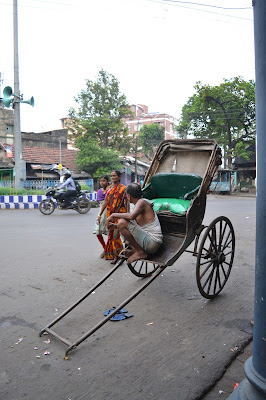Naya Daur
Sitting on his rickshaw parked on the Narkeldanga Main Road, Mehboob was watching the shuttle autos ferry passengers from Phoolbagan to Kaizer Street, Sealdah station and Central Avenue.
“I’m the only one left
in this area,” lamented the 45-year-old from Bihar.
Almost obsolete around
the country, but still going strong, hand-pulled rickshaws are one of the
oldest means of transport in the city.
In the energy-sapping
heat and humidity, his vest was soaked with sweat. He fanned himself with a gamcha.
There’re still some rickshaws near the vegetable markets and local areas, waiting to run you to your destination, but commuters prefer the autos. It saves time and cheaper too.
"I get very little business nowadays. People want to rush. Everything has become so fast. Most rickshaw-pullers have either left the job or went back home,” he added.
There’re still some rickshaws near the vegetable markets and local areas, waiting to run you to your destination, but commuters prefer the autos. It saves time and cheaper too.
"I get very little business nowadays. People want to rush. Everything has become so fast. Most rickshaw-pullers have either left the job or went back home,” he added.
While I waited for
app-cab Ola on the rickety four-point crossing at Khal Pol, I wondered if
the man versus machine competition has rendered the city’s iconic transport
obsolete.
Sadly, Mehboob is not
Shankar of Naya Daur and Kundans are everywhere.
Hari Ram pulled his rickshaw on a rain-soaked humid afternoon through the congested Colootola Street,
a bylane off the rather better-known Chittaranjan Avenue.
He didn’t ferry any
humans, but scrap irons.
“I need money to live. When I don’t get passengers, I often carry good items,” he said.
“I need money to live. When I don’t get passengers, I often carry good items,” he said.
To be continued...



Comments
Post a Comment